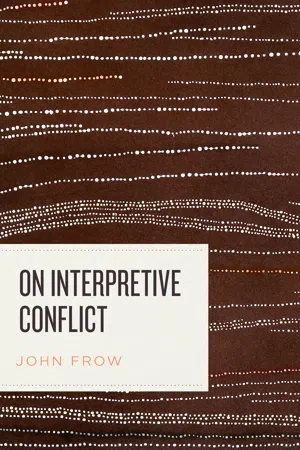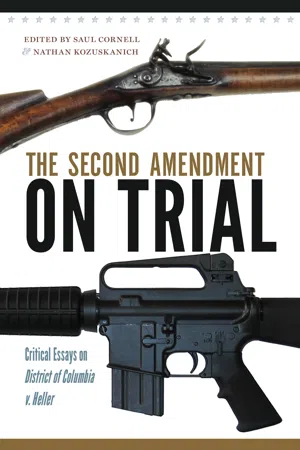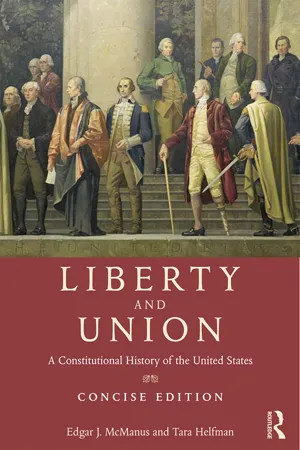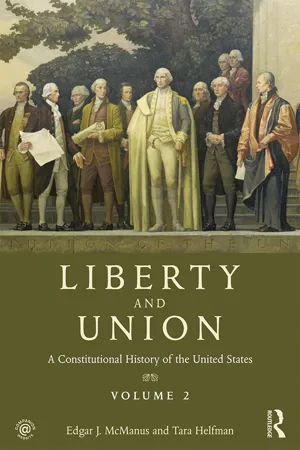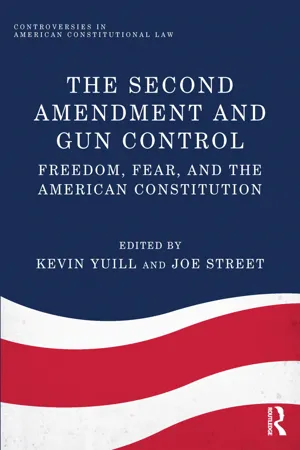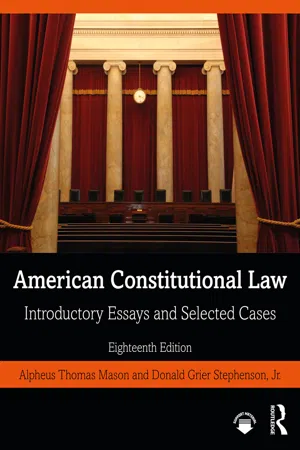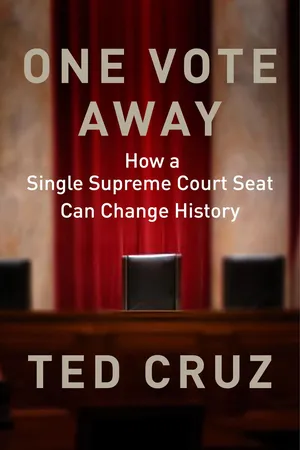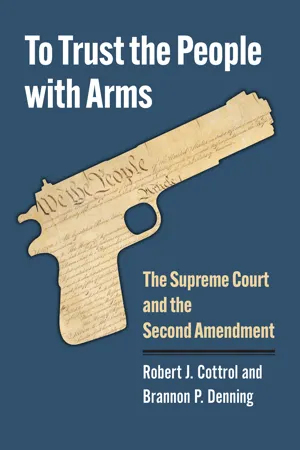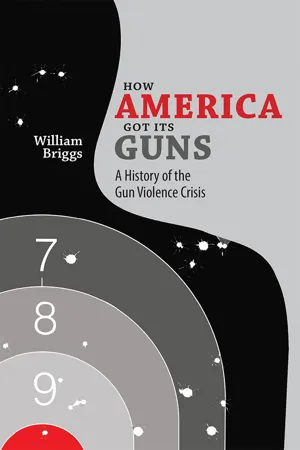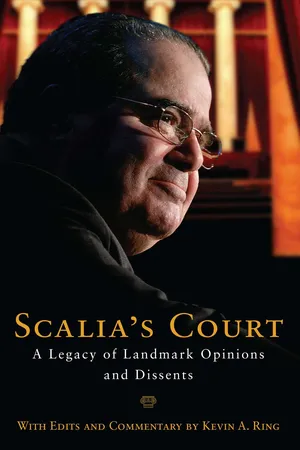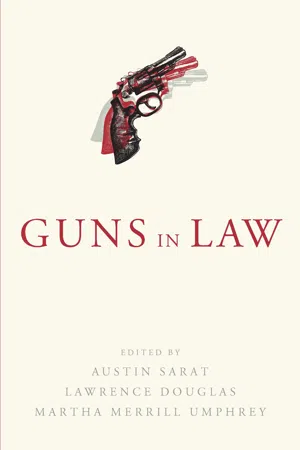Politics & International Relations
District of Columbia v. Heller
District of Columbia v. Heller was a landmark Supreme Court case in 2008 that affirmed an individual's right to possess firearms for self-defense within the home. The case struck down a Washington, D.C. law that banned the possession of handguns and required firearms in the home to be kept nonfunctional. The decision clarified the Second Amendment's protection of an individual's right to bear arms.
Written by Perlego with AI-assistance
Related key terms
12 Key excerpts on "District of Columbia v. Heller"
- eBook - ePub
- John Frow(Author)
- 2019(Publication Date)
- University of Chicago Press(Publisher)
1 Reading with Guns: District of Columbia v. Heller All new laws . .. are considered as more or less obscure and equivocal, until their meaning be liquidated and ascertained by a series of particular discussions and adjudications. «JAMES MADISON 1 » I am not so naïve (nor do I think our forebears were) as to be unaware that judges in a real sense “make” law. But they make it as judges make it, which is to say as though they were “finding” it. «ANTONIN SCALIA 2 » If Kafka writes so intensively about the Law it is because the law, bureaucracy, and theology are the intertwined figures of a hierarchical social order built on the necessity and the impossibility of interpretation. My first case study is of an American judgment that sets in play an interpretive conflict that is resolved with the performative construction of a right and the reality it brings into being. 3 The case of District of Columbia v. Heller, 4 decided by a 5–4 split in June 2008, is remarkable for two reasons: It was the first time that the United States Supreme Court had engaged with the full implications of the Second Amendment to the US Constitution, holding that the amendment articulated the right of private citizens to possess firearms for such purposes as self-defense; and the decision, written by the late Justice Antonin Scalia, was self-consciously and explicitly “originalist,” 5 seeking to determine the “original public meaning” of the text of the amendment without regard to the intentions of those who framed and ratified it, using the text itself as the primary evidence for its meaning at the moment of its enunciation, and confining its legal force to that historically delimited meaning - eBook - ePub
The Second Amendment on Trial
Critical Essays on District of Columbia v. Heller
- Saul A. Cornell, Nathan Kozuskanich, Saul A. Cornell, Nathan Kozuskanich(Authors)
- 2013(Publication Date)
- University of Massachusetts Press(Publisher)
At least for the short term, no law capable of passing the political gauntlet is likely to run afoul of Heller ’s guidelines. Despite an avalanche of lawsuits, there are no signs that any court is likely to read Heller more expansively in the near future. Most courts have accepted that the core of the right protected by Heller extends only to the ownership and use of firearms in the home. 81 Similarly, the Heller Court’s list of reasonable regulations that are presumptively legal, a list that the Court noted was not exhaustive, has covered virtually every existing gun law on the books. It is no less true that the decision is just as likely to remain controversial among scholars for some time to come. As the essays in this volume make clear, the Heller decision is rich in delicious irony: liberals embracing originalism while conservatives thumb their noses at precedent, to name two among many. Although it is too soon to predict how history will judge Heller, it does seem likely that future scholars will uncover additional ironies as they probe the decision further. NOTES 1. District of Columbia v. Heller, 554 U.S. 570 (2008). 2. The Court had last dealt with the Second Amendment in U.S. v. Miller, 307 U.S. 174 (1939), in which it ruled that since shotguns with barrels less than eighteen inches in length had no relation to a well-regulated militia, the Second Amendment did not guarantee a right to keep and bear such firearms. 3. For a brief personal history of the case, see Clark Neily, “District of Columbia v. Heller: The Second Amendment Is Back, Baby,” Cato Supreme Court Review (2007–8): 127–59. The Gura & Possessky, P.L.L.C., website also gives a brief history of the Parker case; see www.gurapossessky.com/news/parker/overview.html. 4. Seegars v. Ashcroft, 297 F. Supp. 2d 201 (D.D.C. 2004). 5 - eBook - ePub
Liberty and Union
A Constitutional History of the United States, concise edition
- Edgar McManus, Tara Helfman(Authors)
- 2014(Publication Date)
- Routledge(Publisher)
Scalia conceded that Second Amendment rights, like other constitutional rights, are not absolute and unconditional. The amendment grants no right to keep and carry any weapon anywhere in any manner for any purpose whatsoever. Reasonable regulation of the right is permissible. Scalia noted that concealed weapons regulations are constitutional, as are prohibitions against the possession of firearms by felons and the mentally ill, as well as laws against the carrying of firearms in particular places such as schools, airplanes, and public buildings. But all such measures must be narrowly tailored to further a compelling public interest in ways that do not destroy the constitutional right. The District of Columbia law failed even to recognize the existence of the right. The handgun ban and trigger-lock requirement, with no exceptions for self-defense, did not reasonably regulate Second Amendment rights but obliterated them completely. Scalia ordered the District of Columbia to register Heller’s handgun and issue him a license to use it in his home.Although Heller certainly qualifies as a landmark decision, its immediate impact on gun control affected regulation only at the federal level. Because the Second Amendment had not yet been incorporated into the Fourteenth, the states still had a free hand to regulate gun ownership. But that was bound to change. Because Heller had elevated gun ownership to the status of a constitutional right that the federal government might not abridge, it logically followed that the states might not abridge the right either. The National Rifle Association and the gun lobby could be counted on to press the issue vigorously. The political climate for promoting Second Amendment rights had never been better. President Barack Obama and Senator John McCain, his Republican rival in the 2008 election, both endorsed the Heller decision. For many observers, it was no longer a question of whether but rather when the Supreme Court would extend the guarantees of the Second Amendment to the states.Proponents of Second Amendment rights had not long to wait. In McDonald v. Chicago (2010), just two years after Heller , the Court struck down ordinances banning handguns in Chicago and its suburb of Oak Park on the ground that the right to keep and bear arms is fully applicable to the states through the Fourteenth Amendment. Although the ordinances had been challenged under both the Privileges or Immunities and Due Process Clauses of the amendment, the plurality opinion by Justice Samuel Alito was based squarely on the latter. To have upheld the Privileges or Immunities challenge would have overturned a mountain of case law based on the narrow interpretation of the clause in the Slaughter-House Cases (1873). This was precisely the course urged by Justice Thomas in his concurring opinion, but the plurality justices thought otherwise. To do so would have resurrected a host of issues best left undisturbed. Besides, incorporating the Second Amendment into the Fourteenth via the Due Process Clause followed the settled jurisprudence of selective incorporation. Like Heller - eBook - ePub
Liberty and Union
A Constitutional History of the United States, volume 2
- Edgar McManus, Tara Helfman(Authors)
- 2013(Publication Date)
- Routledge(Publisher)
Scalia conceded that Second Amendment rights, like other constitutional rights, are not absolute and unconditional. The amendment grants no right to keep and carry any weapon anywhere in any manner for any purpose whatever. Reasonable regulation of the right is permissible. Scalia noted that concealed weapons regulations are constitutional, as are prohibitions against the possession of firearms by felons and the mentally ill, as well as laws against the carrying of firearms in particular places such as schools, airplanes, and public buildings. But all such measures must be narrowly tailored to further a compelling public interest in ways that do not destroy the constitutional right. The District of Columbia law failed even to recognize the existence of the right. The handgun ban and trigger-lock requirement, with no exceptions for self-defense, did not reasonably regulate Second Amendment rights but obliterated them completely. Scalia ordered the District of Columbia to register Heller’s handgun and issue him a license to use it in his home.While Heller certainly qualifies as a landmark decision, its immediate impact on gun control affected regulation only at the federal level. Since the Second Amendment had not yet been incorporated into the Fourteenth, the states still had a free hand to regulate gun ownership. But that was bound to change. Since Heller had elevated gun ownership to the status of a constitutional right that the federal government might not abridge, it logically followed that the states might not abridge the right either. The National Rifle Association and the gun lobby could be counted on to press the issue vigorously. The political climate for promoting Second Amendment rights had never been better. President Barack Obama and Senator John McCain, his Republican rival in the 2008 election, both endorsed the Heller decision. For many observers, it was no longer a question of whether but rather when the Supreme Court would extend the guarantees of the Second Amendment to the states.Proponents of Second Amendment rights had not long to wait. In McDonald v. Chicago (2010), just two years after Heller, the Court struck down ordinances banning handguns in Chicago and its suburb of Oak Park on the ground that the right to keep and bear arms is fully applicable to the states through the Fourteenth Amendment. Although the ordinances had been challenged under both the Privileges or Immunities and Due Process Clauses of the Amendment, the plurality opinion by Justice Samuel Alito was based squarely on the latter. To have upheld the Privileges or Immunities challenge would have overturned a mountain of case law based on the narrow interpretation of the clause in the Slaughter-House Cases (1873). This was precisely the course urged by Justice Thomas in his concurring opinion, but the plurality justices thought otherwise. To do so would have resurrected a host of issues best left undisturbed. Besides, incorporating the Second Amendment into the Fourteenth via the Due Process Clause followed the settled jurisprudence of selective incorporation. Like Heller, - eBook - ePub
The Second Amendment and Gun Control
Freedom, Fear, and the American Constitution
- Kevin Yuill, Joe Street, Kevin Yuill, Joe Street, Kevin Yuill, Joe Street(Authors)
- 2017(Publication Date)
- Routledge(Publisher)
To endure for all time or to change with the times? The Supreme Court and the Second AmendmentEmma LongIntroduction
In June 2008, the US Supreme Court handed down its decision in District of Columbia v. Heller , ruling for the first time that the Second Amendment to the US Constitution guaranteed an individual right to bear arms for the purposes of self-defence. Gun rights activists responded with joy that a majority of the Justices had endorsed a reading of the Amendment that they had advocated for nearly three decades. Gun control supporters expressed disappointment at the Court’s ruling, which struck down what were the strictest gun laws in the nation, but also argued that Heller offered support for their position too. In fact, both leading presidential candidates, John McCain and Barack Obama, publicly offered their support for Heller. 1 How could both sides in the seemingly Manichaean debate between greater gun rights and greater gun control claim support from the same ruling? Because, in reality, Heller offered something to both sides. While finding the Amendment protected an individual right to own firearms separate from militia participation, the Court also clearly stated that right was not unlimited, and it offered what one commentator called a “laundry list” of regulations on gun ownership and use that remained acceptable under the Second Amendment.2 Thus in answering one question (the scope of the right protected by the Amendment), the Court’s ruling in Heller offered up an array of others (exactly what regulations were permitted), guaranteeing continued debate about guns in American society that ensured the Second Amendment would remain relevant well into the twenty-first century.Heller also presented, in stark terms, a clash between two competing theories of constitutional interpretation: originalism versus living constitutionalism. Justice Antonin Scalia, who wrote for the five-Justice majority in Heller , described the ruling as the greatest “vindication of originalism.”3 Emerging initially as a means by which conservatives could criticise the liberal, individual rights rulings of the Warren Court, originalists argued that the meaning of the Constitution should be found by seeking the “intent” of those who created it. Objecting to what they saw as activist judges ignoring the words and meaning of the Constitution in favour of writing their own personal policy preferences into law, advocates offered originalism as a method of restraining the judiciary and “returning” the Constitution to the meaning intended by the Founding Fathers. Scholarly criticism of the methods of original intent led to the development of what has come to be known as “original public meaning, ” the version of originalism found in Heller - eBook - ePub
American Constitutional Law
Introductory Essays and Selected Cases
- Donald Grier Stephenson Jr., Alpheus Thomas Mason(Authors)
- 2021(Publication Date)
- Routledge(Publisher)
In dispute was the validity of an ordinance in the District of Columbia that effectively banned the possession of handguns and required that rifles in the home be disassembled or disabled by trigger locks. Speaking for five justices in striking down the ordinance, Justice Scalia explained that “on the basis of both text and history … the Second Amendment conferred an individual right to keep and bear arms.” Heller is highly significant because it declared for the first time the existence of a personal constitutional right of firearm possession, particularly in the context of self-defense. In so doing, however, Heller has hardly ended the firearms debate. In acknowledging that the Second Amendment right is not “unlimited,” the Court left open the possibility of constitutionally acceptable firearm regulation, as opposed to outright prohibition. Validity would thus presumably turn on reasonableness, although the contours of such regulatory reasonableness must still be determined. Moreover, would the right recognized by Heller apply to state regulation of firearms? This question was crucial because most firearms regulation in the United States is the product not of Congress but of state and local governments. An answer was forthcoming in McDonald v. City of Chicago (2010), which for the first time applied the Second Amendment to the states. Given the developments in Heller and McDonald, the prospects seem strong that the Second Amendment will remain politically and legally significant. Key Terms civil liberty civil right due process of law recusal incorporation ordered liberty total incorporation double standard fair trial rule due process revolution new judicial federalism new double standard Second Amendment Antifederalists Queries Reread the statement by Justice Jackson on the Bill of Rights at the very beginning of this chapter - eBook - ePub
One Vote Away
How a Single Supreme Court Seat Can Change History
- Ted Cruz(Author)
- 2020(Publication Date)
- Regnery(Publisher)
Heller powerfully illustrated the breadth and audacity of the modern Democratic position.Dick Anthony Heller was a federal police officer who lived in Washington, D.C. He carried a firearm at work, but D.C. laws, among the most draconian in the country, made it functionally illegal for him to carry a gun at his home. The D.C. laws prohibited the private possession of any and all handguns, and they required that all long guns (shotguns and rifles) be kept “unloaded and disassembled or bound by a trigger lock or similar device” at all times, with no exceptions (even to defend against imminent threat of violence). In practice, this meant that neither handguns nor long guns could ever be used for home protection or self-defense in the nation’s capital.Dick Heller brought a challenge against those laws in the federal district court in the District of Columbia. He argued that a total prohibition on possessing operative firearms was inconsistent with the core protection of the Second Amendment.The district court rejected Heller’s claim. The argument of the District of Columbia, which the court accepted, was that the Second Amendment does not protect any individual right whatsoever. Instead, D.C. argued, it protects only a “collective right of the militia,” a fancy legal construct that means no person can ever claim that right or have it protected in court. As a practical matter, that interpretation would read the Second Amendment out of the Bill of Rights.When the case went to the court of appeals, I became involved. As the Texas solicitor general, I drafted an amicus brief on behalf of thirteen states that defended an individual - eBook - ePub
To Trust the People with Arms
The Supreme Court and the Second Amendment
- Robert J. Cottrol, Brannon P. Denning(Authors)
- 2024(Publication Date)
- University Press of Kansas(Publisher)
50Dellinger’s argument tracked the district’s brief. First, he would strenuously argue that the right to keep and bear arms guaranteed by the Second Amendment was inseparable from some form of militia service. Later he argued that even if the scope of the right included some right of private gun ownership for self-defense, the District of Columbia was permitted to prohibit certain categories of weapons if, in its opinion, those weapons posed some particular danger to the public, as long as some other alternatives were available (like the rifles and shotguns the district permitted people to possess). Finally, he argued that the district would concede that while the law required the permitted rifles and shotguns to be unloaded and inoperable, if those laws were broken while an individual was engaged in self-defense, that individual should not be prosecuted.51Chief Justice Roberts challenged Dellinger, asking why, if the framers wished to protect only state militias, the Second Amendment referred to “the right of the people.” When Dellinger responded that “the people” and the “militia” were considered one and the same, Roberts suggested that his answer harmed his case. The right, Dellinger responded, was “a right to participate in the common defense and you have a right invocable (sic) in court if a federal regulation interferes with your right to train” for the militia. Given the state of the scholarly debate between the “collective” and “individual” interpretations of the Second Amendment prior toHeller ,Dellinger’s concession at the outset that, whatever its scope, the Second Amendment guaranteed a right that individuals could invoke in court was an interesting one. This point would later be conceded even by - eBook - ePub
Gun Control on Trial
Inside the Supreme Court Battle Over the Second Amendment
- Brian Doherty(Author)
- 2008(Publication Date)
- Cato Institute(Publisher)
, that is, all of us as individuals. He decided that ‘‘bear arms’’ had more than just a military meaning in the idiom of the founding era. He noted the ‘‘sophisticated collective rights theory’’ posited by D.C., but blew it away by noting that it was the functional equivalent of the old collective rights theory— that the Second Amendment right applies to states, not individuals— in that it claims that the individual only has a Second Amendment right in connection with hismembership in a state militia. He also noted that the militia, in the Founding context, consisted of pretty much all able-bodied men, not a select group.Silberman stood up for his court’s right and ability to rethink the Second Amendment afresh, saying he felt no square precedent had been set in their circuit, nor by the Supreme Court. His decision interpretedMiller,the apparent dominant precedent, to say it hinged on the type of weapon the right affected, not the type of person. Silberman did not accept D.C.’s claim that any constitutional infringement was mitigated because the citymight not punish a long gun owner for loading and using his weapon in self-defense in defiance of the letter of the law—‘‘judicial leniency cannot make up for the unreasonable restriction of a right.’’The decision was well-reasoned, but it was only from one three-judge panel of the D.C. Circuit. D.C. officials requested a rehearing by the entire body of judges for the Circuit, known as a rehearing en banc. That request was denied in May 2007. The city then requested, and got, a stay on the order to stop enforcing its law while it decided whether it wished to take the case on to the next step: the Supreme Court of the United States.The decision in Hellerwas ultimately—and appropriately—based on legal and constitutional principles. But underlying the case— inspiring the plaintiffs to challenge the law and explaining why the decision alternately delighted and horrified many Americans—are powerful ideas and practices that underlie and also go beyond what the Second Amendment does or doesn’t mean. They have to do with self-defense and self-identity, and they aren’t so much about the Constitution or empirical reality as they are about a wider and deeper cultural war. - eBook - ePub
How America Got Its Guns
A History of the Gun Violence Crisis
- William Briggs(Author)
- 2017(Publication Date)
- University of New Mexico Press(Publisher)
Heller decision also applied to the states. Shadur’s responded, Not so fast; that is a decision for judges above myself.The cases met a similar fate when they were consolidated and heard in the Seventh Circuit Court in June 2009. The three-judge panel, headed by esteemed Circuit Judge Frank Easterbrook, cited precedents that it was unwilling to overrule and it upheld the local ordinances—but not before suggesting how it might rule if it had the authority.The Constitution establishes a federal republic where local differences are to be cherished as elements of liberty rather than extirpated in order to produce a single, nationally applicable rule…. Federalism is an older and more deeply rooted tradition than is a right to carry any particular kind of weapon. How arguments of this kind will affect proposals to “incorporate” the second amendment are for the Justices rather than a court of appeals.7The plaintiffs showed their determination to bring their cases to a judgment day. One day after the Seventh Circuit Court handed down its decision, the NRA submitted a petition for a writ of certiorari—the formal request for the Supreme Court to hear a case. One week later, the McDonald team filed its petition. Given the recent Heller decision and the urgent question about its applicability to the states, the Supreme Court granted the petition for the McDonald case on September 30, 2009. The case would be heard by the high court in less than six months.The granting of certiorari was like a cannon fired at the start of a six-month race. Armadas of attorneys set sail and began preparing the required merits briefs for the petitioners (the McDonald side) and the respondents (the City of Chicago). Although the court did not grant the NRA’s petition for certiorari - eBook - ePub
Scalia's Court
A Legacy of Landmark Opinions and Dissents
- Antonin Scalia, Kevin A. Ring, Kevin A. Ring(Authors)
- 2016(Publication Date)
- Regnery(Publisher)
District of Columbia v. Heller (2008)Well known for having some of the strictest gun control laws in the country, the District of Columbia government made it illegal for residents to own a handgun unless the chief of police issued the resident a one-year license. D.C. law also required that all firearms be kept unloaded and disassembled or bound by a trigger lock unless the firearms were located in a place of business or were being used for legal recreational activities.A D.C. special police officer named Dick Heller challenged the law. Heller, who was authorized to carry a handgun while on duty, had applied for a license to keep his gun at home, but the chief denied his request. Heller argued that the D.C. law restricting the licensing of handguns and requiring all licensed guns to be kept disassembled violated his individual right guaranteed by the Second Amendment to keep and bear arms.The district court dismissed Heller’s complaint, but the U.S. Court of Appeals for the D.C. Circuit reversed, holding that the Second Amendment protects the right to keep firearms in the home for the purpose of self-defense. The court ruled that the District’s requirement that firearms kept in the home be nonfunctional violated that right.In a lengthy, history-filled opinion, Justice Scalia argued that the Second Amendment, as understood by those who wrote and ratified it, guaranteed the right of self-defense for individuals. Scalia argued that the amendment has a prefatory clause and an operative clause, and that the prefatory clause’s reference to “militia” does not limit the substantive individual right protected by the operative clause. Scalia further noted that the term “militia” referred at the time to all able-bodied men who might be capable of being called into military service. “There seems to us no doubt, on the basis of both text and history, that the Second Amendment conferred an individual right to keep and bear arms,” Scalia wrote for the Court. - eBook - ePub
- Austin Sarat, Lawrence Douglas, Martha Merrill Umphrey, Austin Sarat, Lawrence Douglas, Martha Merrill Umphrey(Authors)
- 2019(Publication Date)
- University of Massachusetts Press(Publisher)
10The roots of this historical paradox, rewriting history at the same time that it made history foundational to the future of Second Amendment law, can be traced to Justice Scalia’s statement that “constitutional rights are enshrined with the scope they were understood to have when the people adopted them, whether or not future legislatures or (yes) even future judges think that scope too broad.”11 In another oft-quoted passage from Heller, the majority made another related assertion:Although we do not undertake an exhaustive historical analysis today of the full scope of the Second Amendment, nothing in our opinion should be taken to cast doubt on longstanding prohibitions on the possession of firearms by felons and the mentally ill, or laws forbidding the carrying of firearms in sensitive places such as schools and government buildings, or laws imposing conditions and qualifications on the commercial sale of arms.12Heller clearly points to history for guidance in evaluating the constitutionality of gun regulation, but it offers little substantive insight or methodological guidance on how to ferret out that information. According to Heller, the legality of a particular gun law would seem to depend on whether it can be shown to be deeply rooted in some American legal or regulatory tradition.13 An understanding of the evolving nature of the right to keep and carry arms is not only essential to correcting the historical record and implementing Heller’s historical framework, but it may also aid in resolving some of the contradictions and jurisprudential problems created by the opinion.14 In his dissent, Justice Breyer suggested a balancing model that Justice Scalia dismissed as incompatible with the original understanding of the right to keep and bear arms. Balancing was central to the way members of the founding generation approached issues related to firearms. In fact, balancing was indispensable to the Anglo-American law of firearms.15 The liberty interest associated with the right to arms was always balanced against the concept of the king’s peace.16 If an individual’s exercise of the right to bear arms threatened the peace and order of the realm, that individual could be disarmed, imprisoned, and forced to provide a surety, a type of peace bond.17 Simply arming oneself was contrary to law and was by its nature a violation of the king’s peace under English law. A complex framework had developed under English common law that determined if subjects could lawfully arm themselves in public. The American Revolution republicanized the concept of the king’s peace by transmuting it into the people’s peace, but this did not repudiate the centrality of the balancing process used to determine if armed travel violated the peace.18 The Revolution did lead to an expansion in the number of circumstances in which traveling armed might be lawful, but it did not create a broad freestanding right to travel armed in public.19
Index pages curate the most relevant extracts from our library of academic textbooks. They’ve been created using an in-house natural language model (NLM), each adding context and meaning to key research topics.
